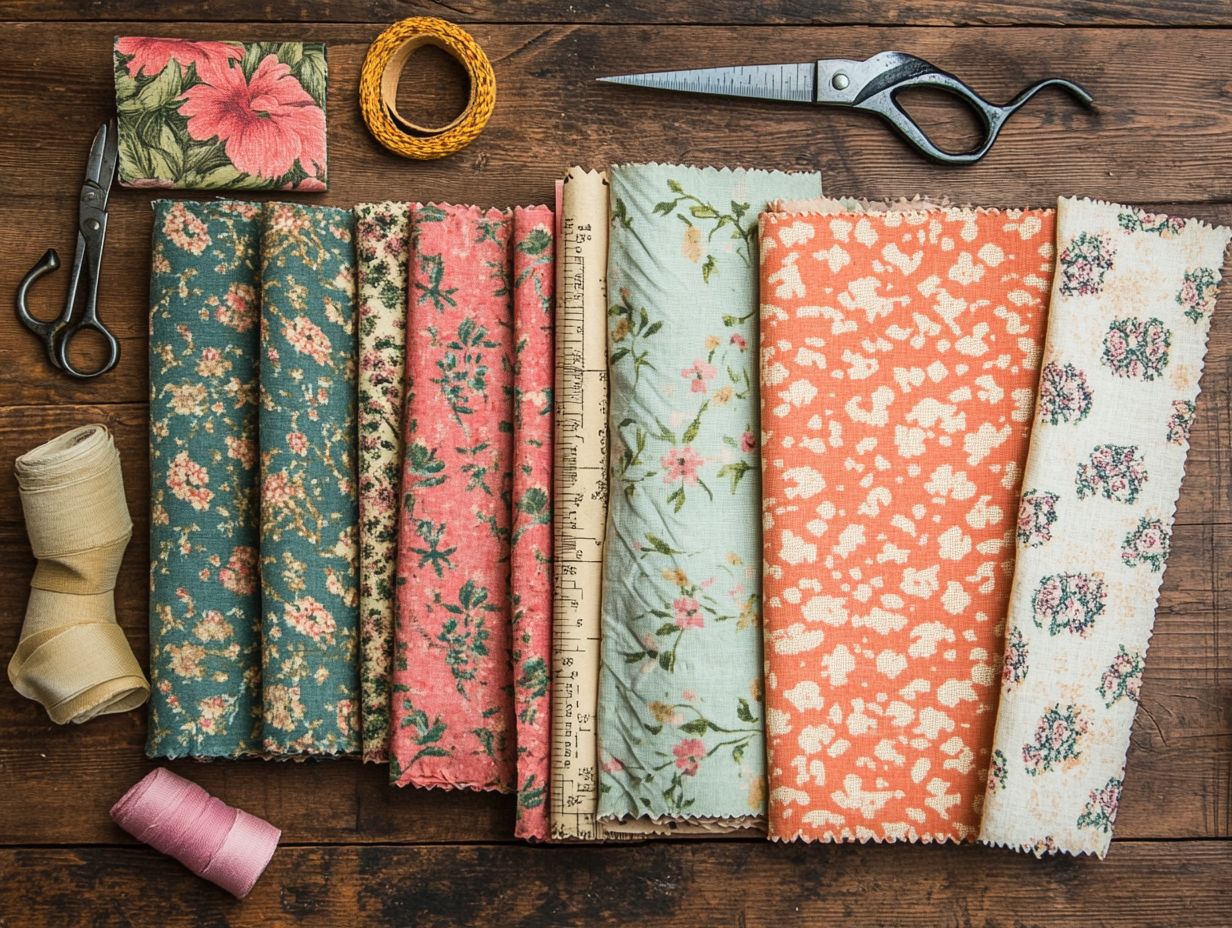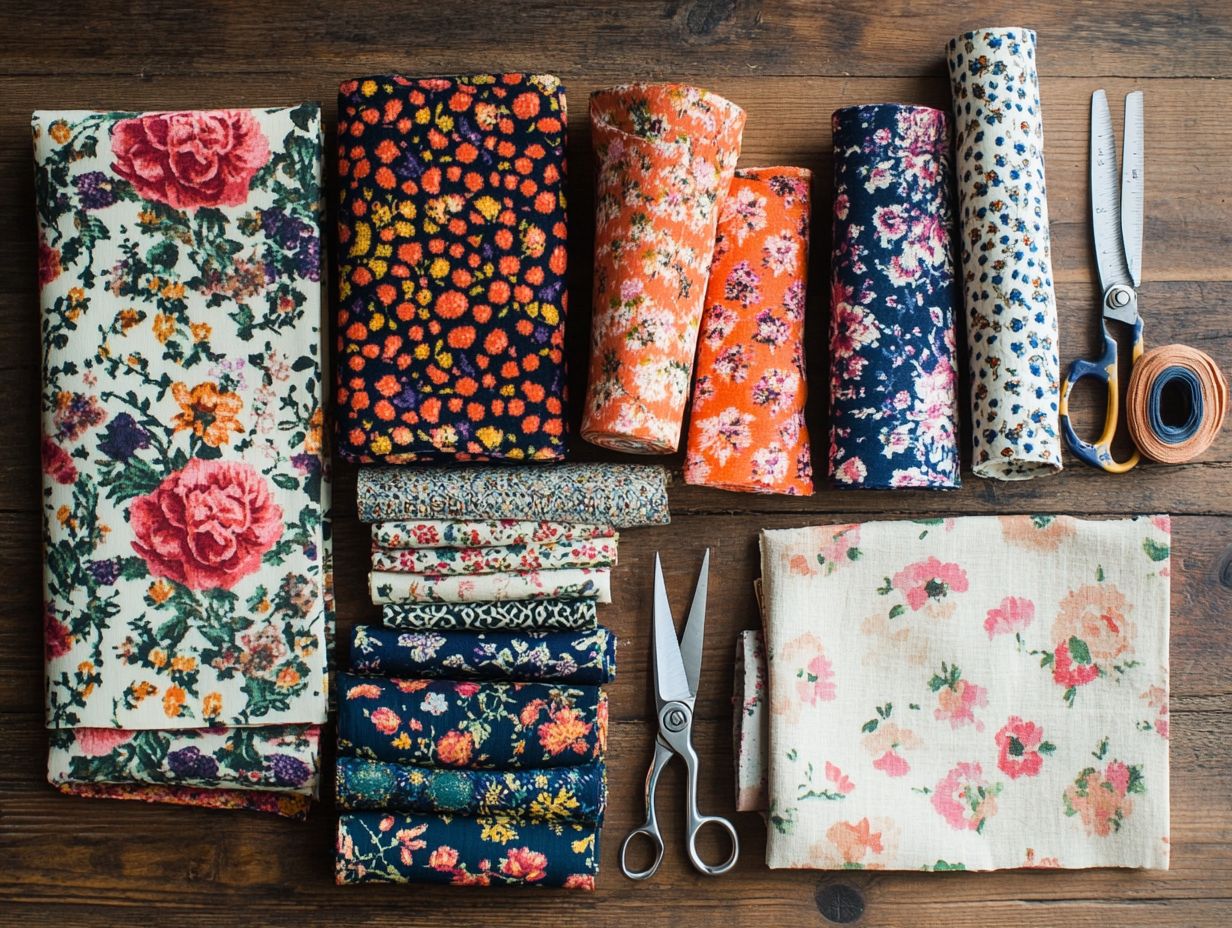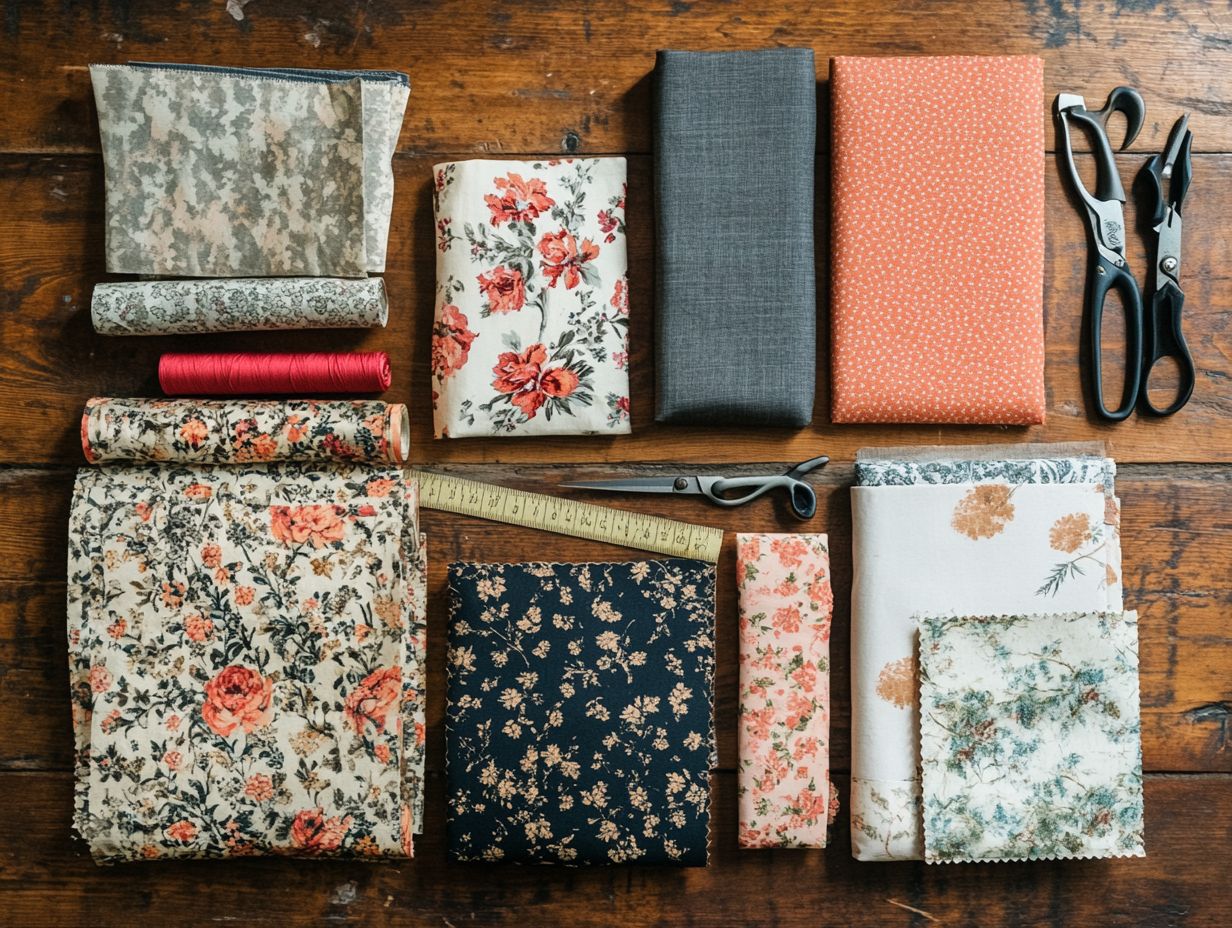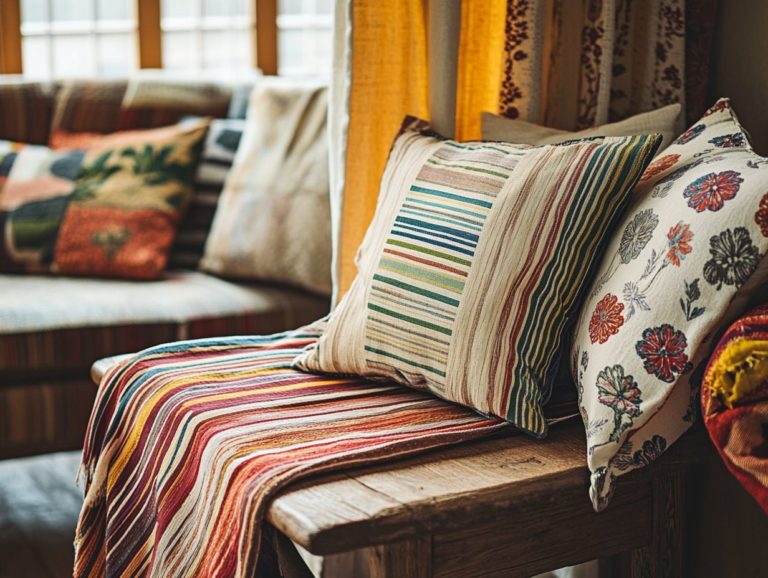How to Choose Vintage Fabrics for Upholstery
Vintage fabrics, including options like silk velvet and performance fabric, infuse a unique charm and character into any space. However, selecting the right ones for upholstery can be delightful yet daunting.
This article delves into what defines a vintage fabric, offering essential factors for you to consider such as quality, design, and how well it harmonizes with your decor. You ll discover the most popular fabric types, from luxurious silk to cozy wool, and quality fabrics like leather and acrylic, giving you a comprehensive overview to guide your choices.
You ll find valuable tips on caring for your vintage upholstery, ensuring it remains timeless and beautiful for years to come.
Ready to transform your home with vintage elegance? Let s dive in!
Contents
- Key Takeaways:
- Understanding Vintage Fabrics
- Factors to Consider when Choosing Vintage Fabrics for Upholstery
- Common Types of Vintage Fabrics for Upholstery
- Tips for Caring for Vintage Upholstery Fabrics
- Frequently Asked Questions
- What should I consider when choosing vintage fabrics for upholstery?
- How can I determine the durability of a vintage fabric for upholstery?
- Is it important to match the color and pattern of vintage fabric to my furniture?
- Can I use vintage fabrics for upholstery in any room of my home?
- Where can I find vintage fabrics for upholstery?
- Do I need to prepare vintage fabrics before using them for upholstery?
Key Takeaways:

- Consider quality and durability when choosing vintage fabrics for upholstery.
- Choose vintage fabrics that complement your existing d cor.
- Proper maintenance is essential for preserving vintage upholstery.
Understanding Vintage Fabrics
Understanding vintage fabrics is crucial for homeowners and interior designers looking to enhance their home decor with a hint of nostalgia. These fabrics often showcase distinctive patterns, textures, and colors that can elevate ordinary furniture into extraordinary statement pieces.
Whether you re searching for luxurious vintage silk velvet to create a plush ambiance or a sturdy cotton blend for practicality, familiarizing yourself with the characteristics of these materials will inform your selection.
Integrating vintage upholstery into your home office can cultivate a cozy yet sophisticated atmosphere, transforming it into a delightful space to inspire your creativity and productivity.
What Makes a Fabric Vintage?
A fabric becomes vintage when it showcases unique characteristics that embody a specific era, often distinguished by its composition and craftsmanship. Vintage fabrics are exceptional due to their rarity, quality, and historical significance, making them highly sought after by collectors and DIY enthusiasts.
Understanding cleaning codes which indicate how to care for different fabrics is essential for preserving the beauty of these materials, especially when working with delicate or expensive fabrics.
The intricate weave of silk, the luxurious touch of velvet, and the crisp texture of linen all enhance the charm and authenticity of vintage textiles. Each material tells its story and influences how it ages and responds to various cleaning methods.
Proper care is vital for maintaining the integrity of these timeless fabrics, as improper cleaning can lead to irreversible damage. As a vintage textile enthusiast, familiarize yourself with specialized cleaning techniques to ensure that your treasured pieces remain as stunning as the day they were crafted.
Factors to Consider when Choosing Vintage Fabrics for Upholstery
When selecting vintage fabrics for upholstery, several essential factors come into play to ensure your choice aligns with both aesthetic and functional needs. Prioritizing quality and durability is crucial, especially if you re upholstering furniture that will experience daily use, such as swivel club chairs or accent pieces in your home office.
Partnering with an interior designer can provide invaluable insights into which vintage fabrics like performance velvet or luxurious fabric blends will beautifully complement your decor while maintaining their longevity.
Quality and Durability
Choosing vintage fabrics can truly transform your upholstery projects! Quality and durability should be your top priorities, especially in high-traffic areas like Living Rooms or Home Offices. Fabrics with high durability ratings signal better durability, making them ideal for everyday use.
By opting for stain-resistant performance fabrics, you can ensure that your vintage upholstery remains both beautiful and functional over time. As you assess fabric quality, consider the weave, fiber content, and finish. If you’re looking for inspiration, check out this guide on how to choose vintage furniture for your bedroom.
Conducting durability tests, such as checking abrasion and the ability of fabric to retain its color when exposed to sunlight, will help you determine whether the fabric can withstand wear and environmental factors. Durability ratings become crucial indicators fabrics rated above 20,000 double rubs are often perfect for heavily used furniture.
If you re aiming to strike a balance between style and practicality, you have many options, from classic tweeds and boucl s to contemporary solutions like microfibers and recycled polyesters. Each offers its unique character while ensuring longevity in your upholstery projects.
Design and Aesthetic Appeal
The design and aesthetic appeal of vintage fabrics can dramatically elevate the visual intrigue of your home decor. Fabrics like blush Ralph Lauren or rich green velvet can act as compelling focal points, transforming spaces with their unique textures and vibrant colors.
It s essential to select fabrics that resonate with your personal style and harmonize with your existing design scheme. Incorporating a variety of patterns, such as bold florals or classic stripes, can completely redefine a room s ambiance.
For example, imagine a plush sofa adorned with modern abstract cushions. When paired with a vintage geometric rug, it creates a striking contrast that beautifully juxtaposes different eras.
By mixing contemporary pieces with antiques, like a mid-century modern chair accompanied by a soft, woven throw in a warm terracotta hue, you can strike a delightful balance between nostalgia and current trends. This thoughtful layering of textures and colors rejuvenates your decor and narrates a unique story of your personal taste.
Compatibility with Existing D cor

When selecting vintage fabrics for upholstery, assess their compatibility with your existing decor to achieve a harmonious look throughout your home. The fabric you choose should complement not just the color palette, but also the overall style of the room.
Engaging with an interior designer can provide valuable insights into fabric selection that elevates the aesthetic of spaces like your Home Office. A strategic approach involves examining color matching and style cohesion.
Utilizing a color wheel (a tool used for color selection) can ensure that your vintage fabric harmonizes beautifully with contemporary elements by identifying complementary hues. Incorporating patterns can add dynamic visual appeal.
However, it s crucial to strike a balance between the boldness of vintage prints and the sleekness of modern designs. Mixing textures can also enrich the overall feel; consider pairing a soft, vintage fabric with streamlined modern furnishings to create an inviting yet sophisticated atmosphere.
Explore your options and consult a designer to help you choose the perfect vintage fabrics for your home!
Common Types of Vintage Fabrics for Upholstery
Many classic vintage fabrics are popular for upholstery, including leather and cotton. Each fabric has unique qualities suited to various design styles and practical needs.
Silk and velvet, especially performance velvet, radiate luxury and sophistication. They can elevate any space with their opulent appearance.
Laid-back options like wool and cotton offer comfort and durability, making them perfect for everyday use. By understanding these fabrics, you’ll choose the best one for your project.
Silk
Silk is a luxurious vintage fabric known for its softness and sheen. It s a fantastic choice for upholstery that impresses.
While silk feels opulent, it has a price tag and needs special care to stay beautiful. Knowing how to care for silk is vital, especially in busy areas.
Silk is also less likely to cause allergic reactions and breathable, making your living room or bedroom inviting. However, it may fade and stain easily, especially in sunlight or from spills.
To keep your silk upholstery looking great, avoid direct sunlight and consider protective treatments. Opt for professional cleaning when needed.
With care and regular maintenance, silk can turn your room into a sophisticated retreat, showcasing its timeless elegance.
Velvet
Velvet is a beloved vintage fabric that adds depth and richness to interiors. It s a timeless choice for upholstery projects.
This exquisite material comes in various forms, like crushed velvet with unique texture and light-catching features. Burnout velvet is known for intricate patterns made through a chemical process.
Each type has its character; crushed velvet works well for plush seating, while burnout velvet is great for decorative cushions or drapes. Performance velvet combines elegance with practicality, featuring stain-resistant qualities ideal for families or busy spaces.
With these velvet options, you can creatively transform your spaces into luxurious havens of comfort and style.
Wool
Wool is a timeless fabric that provides warmth and a rich texture. It s perfect for upholstery in colder areas or cozy spaces.
Its natural elasticity ensures durability, keeping it in shape over time. Wool fits various styles, from rustic charm to sleek contemporary designs.
This versatile material features elegant weaves and vibrant colors, enhancing any design theme. Wool s breathability helps regulate temperature, ensuring comfort whether you sit on a plush sofa or a stylish chair.
Consider using wool upholstery in a chic Scandinavian-style living room for a warm, inviting feel. Or choose bold geometric patterns for a modern touch in urban settings.
Thanks to wool s natural stain resistance, it s a savvy option for homes with children or pets. Beauty and functionality really can go hand in hand!
Cotton
Cotton is a wonderfully versatile vintage fabric frequently used in upholstery. Its breathability and low-maintenance nature make it an ideal choice. With a vast array of colors, patterns, and weights at your disposal, cotton can effortlessly blend into various design themes. This versatility makes it a favored choice for both casual and formal settings.
Its affordability, paired with its aesthetic charm, ensures that cotton remains a go-to fabric for vintage upholstery projects.
Different types of cotton fabrics like percale, sateen, and denim each bring unique textures and characteristics. For example, percale boasts a crisp finish, making it perfect for lightweight curtains or delicate chair covers. On the other hand, denim shines in durability, making it an excellent choice for slipcovers that can withstand the delightful chaos of family life.
Each of these options can enhance your home decor, offering a range of solutions that cater to both functionality and style.
Linen

Linen is a timeless fabric celebrated for its elegance and breathability, making it a go-to option for upholstery in warmer climates. As a natural fiber, linen adds style to any space while preserving a relaxed vibe.
Its distinctive texture and draping qualities open up a world of creative possibilities, whether you’re aiming for beachy chic or classic elegance.
However, while linen certainly brings a unique charm to vintage upholstery, it does have its quirks. This fabric is notorious for wrinkling, which can compromise its polished look over time. To counter this, opt for a heavier linen blend that balances durability with elegance.
When styling, consider layering linen with other textures like velvet or leather to introduce visual richness and depth to your room.
In terms of upkeep, a little gentle cleaning and spot treatment go a long way in keeping your linen looking fresh. With just a touch of maintenance, your space will radiate timeless beauty without sacrificing comfort.
Leather
Leather stands as a vintage upholstery material that embodies durability and timelessness. It is an exceptional choice for both functional and aesthetic purposes. Its natural resilience guarantees longevity, while the unique aging process gives it character over time.
Whether you opt for a standout piece or subtly integrate it into your decor, leather has the remarkable ability to elevate any vintage upholstery project.
Leather is versatile and fits many styles, ranging from rustic charm to contemporary elegance. It seamlessly fits into various interior design themes.
Each type be it full-grain, top-grain, or corrected-grain leather offers distinct qualities and textures. Understanding these types can enhance the appeal of your furniture pieces.
With a rich palette of natural colors at your disposal, leather easily complements any color scheme. When properly cared for, leather not only withstands the test of time but also breathes life into vintage settings, ensuring that your pieces remain both functional and stylish for years to come.
Tips for Caring for Vintage Upholstery Fabrics
Caring for vintage upholstery fabrics is essential for preserving their beauty and longevity. This ensures that your investments continue to enrich your home decor for years to come.
Regular maintenance and familiarizing yourself with the specific cleaning codes for each fabric type can significantly enhance their durability.
By using water-based products and adhering to care guidelines, you can keep your vintage fabrics looking vibrant and stunning, showcasing their timeless elegance.
Start caring for your vintage upholstery today and watch your home transform!
Cleaning and Maintenance
Cleaning and maintaining vintage upholstery is essential to preserving the fabric’s original beauty and functionality. Proper care can prevent damage and extend the life of your upholstered treasures.
By following specific cleaning instructions for each fabric type whether it be silk, velvet, or something else you can ensure your vintage fabrics always look their best. Regular cleaning, coupled with careful handling, is key.
Before diving into any cleaning task, it’s crucial to identify the correct cleaning codes, typically found on labels sewn into the fabric. For example, a W indicates that water-based cleaning is safe, while an S signifies that solvents should be used. For delicate materials like lace or brocade, hand washing may be the best approach, while cotton often tolerates more vigorous methods.
By taking the time to research and implement these codes, you can effectively eliminate stains and dirt without compromising the integrity of your cherished pieces, allowing them to be enjoyed for many more years to come.
Preservation and Restoration
Preserving and restoring vintage upholstery is crucial for maintaining both the fabric’s integrity and its historical significance in your home decor. Engaging in DIY restoration projects allows you to breathe new life into cherished furniture. Opting for professional restoration ensures that your investment retains its value and beauty.
Whether you decide to preserve a vintage piece with simple cleaning or embark on a more complex restoration, understanding the best practices is essential. Utilizing techniques like putting new fabric on your furniture or applying protective finishes enables you to tackle minor damages on your own, making the process both rewarding and cost-effective.
For more delicate fabrics or intricate designs, enlisting a skilled professional guarantees that the work honors the original craftsmanship. Both approaches significantly contribute to extending the life of your treasured pieces, ensuring they remain functional and visually appealing for future generations.
By carefully weighing your options, you can make informed decisions that enhance your living spaces while honoring the artistry of the past.
Frequently Asked Questions
What should I consider when choosing vintage fabrics for upholstery?

When choosing vintage fabrics for upholstery, consider the fabric’s durability, color and pattern, and its compatibility with your furniture and overall decor scheme.
How can I determine the durability of a vintage fabric for upholstery?
Want your vintage piece to last? Check its fiber content and weave. Fabrics made from natural fibers such as cotton, linen, or wool are typically more durable than synthetic fabrics. Tightly woven fabrics are more durable than loosely woven ones.
Is it important to match the color and pattern of vintage fabric to my furniture?
While it’s not necessary to match the color and pattern of the vintage fabric to your furniture, think about how they will work together. If you have bold or busy furniture, a simple and subtle vintage fabric may work better, and vice versa.
Can I use vintage fabrics for upholstery in any room of my home?
Yes! Vintage fabrics can be used for upholstery in any room of your home. However, it’s important to consider the fabric’s durability and the room’s function. For high-traffic areas, you may want to choose a more durable fabric, such as stain-resistant options or those with a specific fabric composition.
Where can I find vintage fabrics for upholstery?
You can find vintage fabrics for upholstery at specialty vintage shops, flea markets, and online marketplaces. You can also repurpose vintage clothing or linens into fabric for upholstery. Additionally, consider checking out collections from popular brands like Ralph Lauren, West Elm, or Fabricut.
Ready to transform your space? Start your vintage upholstery journey today!
Do I need to prepare vintage fabrics before using them for upholstery?
Yes, it’s essential to prepare vintage fabrics before upholstering. This ensures they are clean and free from pests or odors.
You can do this by gently washing the fabric or having it professionally dry cleaned. If you re taking on a DIY project, consider using water-based products for best results.






